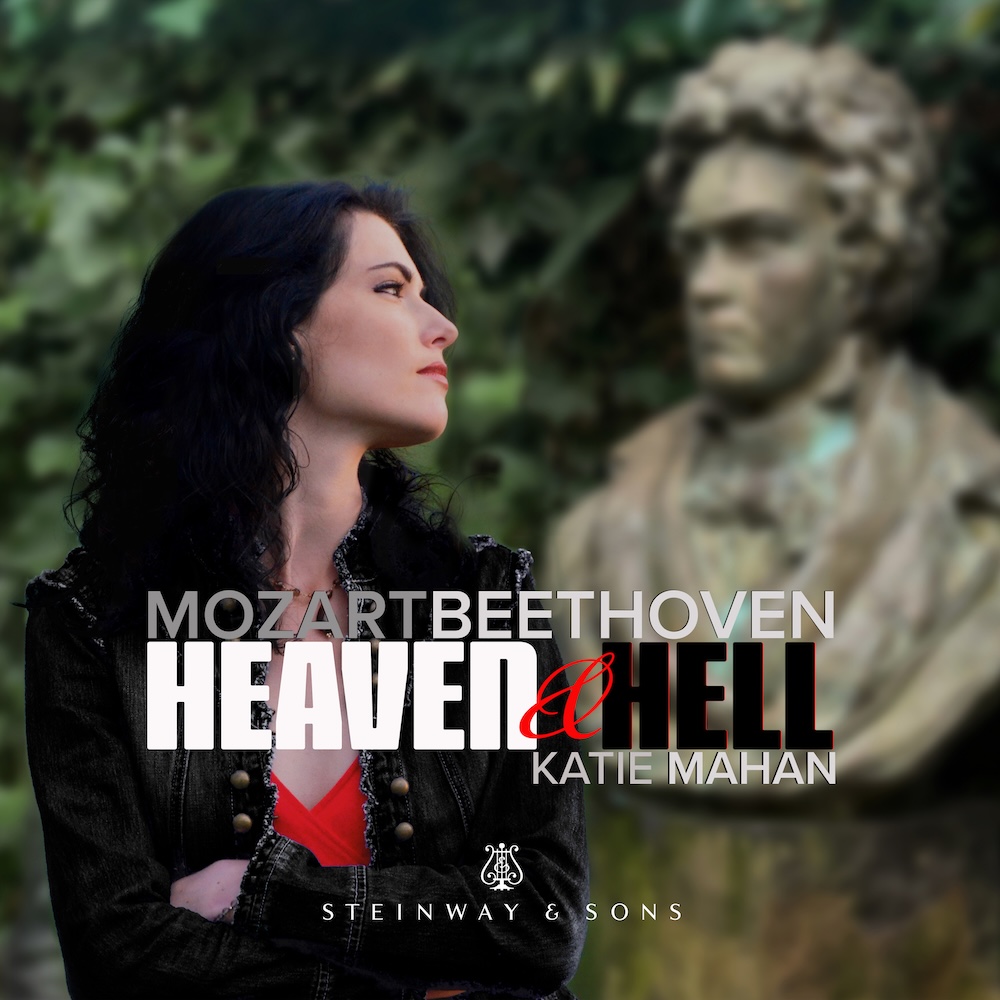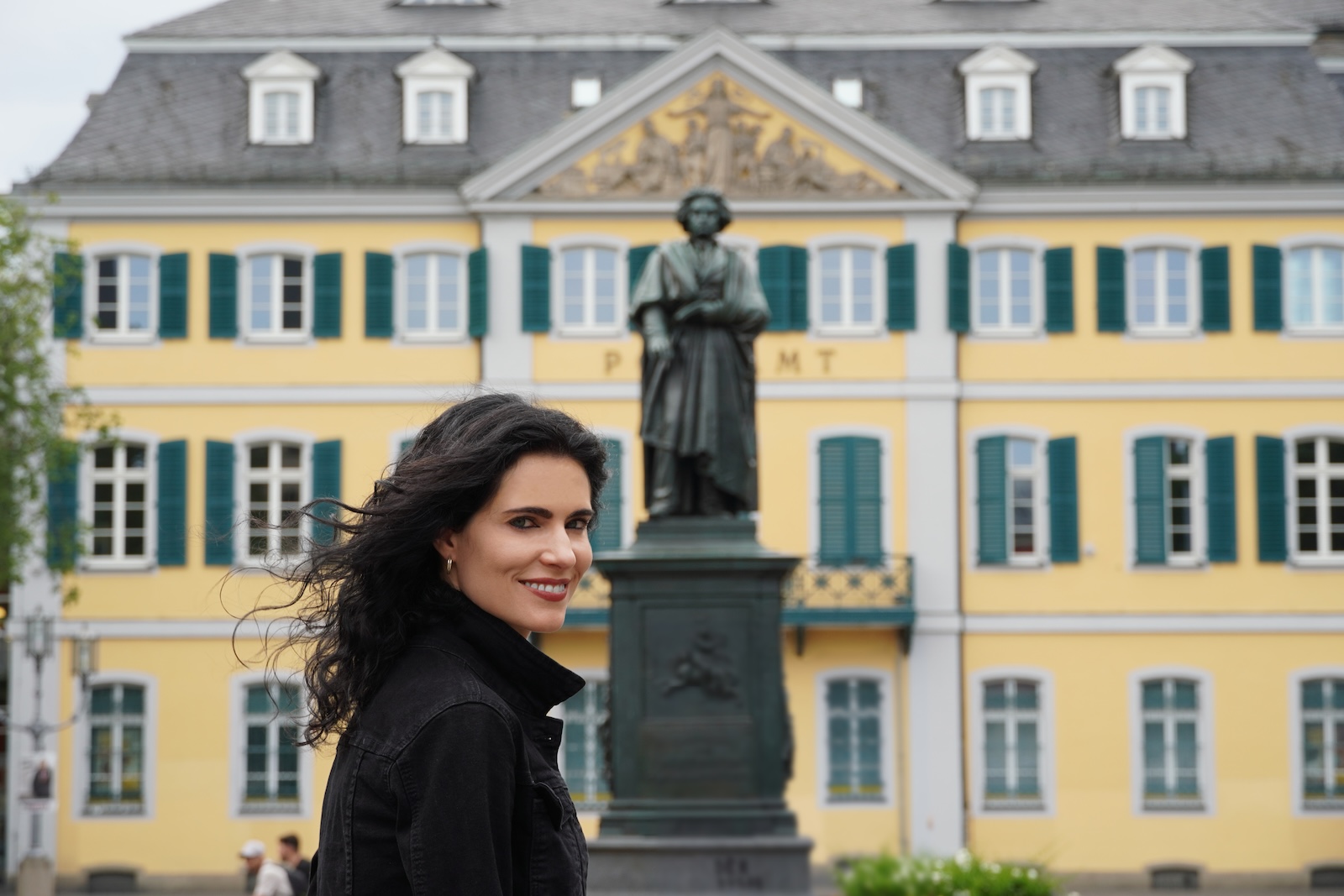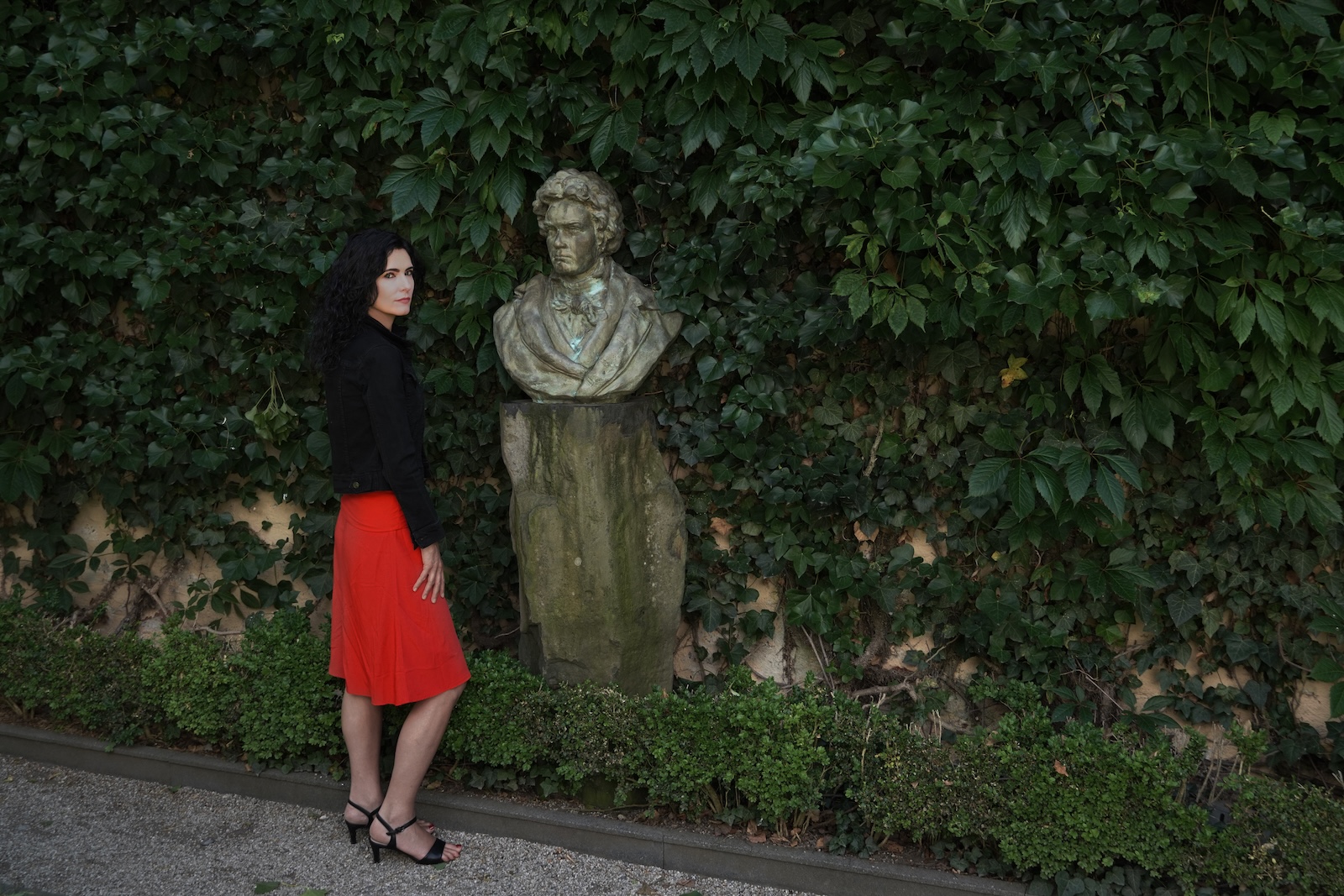Heaven and Hell
Mozart•Beethoven
Katie Mahan
Pianist Katie Mahan explores the deep artistic and spiritual connection between Mozart and Beethoven. The beloved Moonlight Sonata and Für Elise Bagatelle are featured as well as Mahan’s own transcriptions of Mozart’s Don Giovanni Overture and the transcendent Ode to Joy from Beethoven’s 9th Symphony.

STEINWAY & SONS is thrilled to release Katie Mahan's newest album, Heaven and Hell - Mozart, Beethoven, (STNS 30252) on October 3, 2025. Beethoven's beloved Moonlight and Waldstein sonatas are featured along with the monumental Sonata Op. 111, and Mahan’s own transcriptions of Mozart’s Don Giovanni Overture, “Ah, soccorso!” and the transcendent "Ode to Joy" from Beethoven’s 9th Symphony.”
In her liner notes for the album Mahan writes:
“I have chosen to begin this program with my own solo arrangement of the Overture to Don Giovanni because my motivating idea for this album is the golden thread of conscience between Mozart and Beethoven. The extremes of heaven and hell as so brilliantly depicted by Mozart in Don Giovanni must have dwelt in Beethoven throughout his life and formed a subconscious basis from which he ascended to unimaginable attainment. It is this evolution that I seek to depict with this album.
Before discussing the short selection entitled “Ah, soccorso!” that follows the Overture to Don Giovanni on this album, I would like to segue into Beethoven’s Sonata quasi una fantasia No. 14 in C-sharp minor Op, 27, No. 2 - a work which is certainly among the most popular pieces of music ever written. For many listeners, this sonata, known around the world simply as the “Moonlight” Sonata, brings to mind the dark and romantic image of a solitary boat floating on the shimmering moonlit waters of an alluring lake where wooded mountains rise high in the distance. This depiction of the sonata is attributed to Heinrich Friedrich Ludwig Rellstab, considered by some to be the first great music critic, from a serialized story he wrote for publication in the Berliner allgemeine musikalische Zeitung in the summer of 1824. Although Beethoven and Rellstab met in Vienna in 1825, as is evidenced by written exchanges inBeethoven’s conversation books, it is not clear whether or not Beethoven was aware of Rellstab’s depiction of his Sonata Op. 27, No. 2. What is clear, however, is that Beethoven himself did not give the work the title “Moonlight,” and that the work most likely had a very different genesis.
There are a number of sketches in existence in which Beethoven copied out sections of Don Giovanni by hand. Of particular relevance is the fact that in the early 20th century, the Swiss pianist Edwin Fischer discovered a sketch in the archives of the Musikverein in Vienna in which Beethoven had copied out the music to “Ah, soccorso!” (“Ah, help!” from Act I, Scene I), the aria in which Don Giovanni kills the Commendatore. I have included my own solo arrangement of “Ah, soccorso!” from Mozart’s Don Giovanni - transcribed to C-sharp minor as Beethoven did in his hand-copied sketch of Mozart’s original - as a prelude to the “Moonlight” Sonata. I invite each my listeners to sit back, listen and contemplate the connection between the music of the two composers and decide for yourself whether it captures your imagination the way it captured mine.
Next we veer away from the drama of Don Giovanni to the ever popular Bagatelle in A minor, WoO 59, known as Für Elise. The original manuscript for this miniature has been lost without a trace, and although likely composed in 1810, it was first published in 1867 by the Beethoven scholar Ludwig Nohl who claimed to have seen the original autograph score. There is unfortunately only a single remaining sketch leaf for Für Elise which also contains sketches for other works and is part of a larger collection known as the “Sauer” sketchbook. Furthermore, there is no title or dedication whatsoever on the leaf; it is simply marked “No 12.” We therefore have to take Nohl’s word for it that the manuscript included the dedication “Für Elise am 27. April zur Erinnerung von L. v. Bthvn.”
We now come in the program to one of the crowning achievements of Beethoven’s middle period and a milestone in the piano repertoire, the Sonata No. 21 in C Major, Op. 53 “Waldstein,” dedicated to Beethoven’s early friend and mentor Ferdinand Ernst Joseph Gabriel, Count von Waldstein und Wartenberg. The “Waldstein” Sonata is a revolutionary and technically brilliant work. Beethoven takes the sound world of the earlier “Moonlight” Sonata a step farther, using trills, shifts of register and further development of special pedal effects in the pursuit of a new way of achieving effects of tone color, washes of sound, orchestral effects and expressive possibilities on the piano. Where in the “Moonlight” Sonata, Beethoven takes us on a journey into the depths of darkness and the raging fires of hell, in the ‘“Waldstein” sonata, he takes us on a journey into the ethereal lightness of dawn and the vision of heaven.
We now move forward in time to 1821 and the Sonata No. 32 in C minor Op. 111. Beethoven’s final sonata for the piano is a miracle of human expression. It is a mirror of Beethoven’s own life, and the culmination of his artistic vision and evolution. It is a work of visceral emotion and an intensely personal reflection of his morality. It is as revolutionary as Don Giovanni; it transcends mere musical composition and offers us a glimpse into his very soul.
The final work on this album, the “Ode to Joy” from Beethoven’s revolutionary Symphony No. 9 in D minor, Op. 125, is one of the most revered and beloved compositions in the history of western music, and an affirmation of the power of the human spirit to overcome adversity even in the face of darkness. With text based on an ode written in 1785 (and later revised) by the German poet Friedrich Schiller, it is a celebration of the unity of humanity and a testament to Beethoven’s own journey from chaos to serenity, from hell to heaven.”
— Katie Mahan
“There is some undefinable essence that Mahan seems to draw out of the music, out of the piano that catches the listener and commands attention.”
Fanfare
“With the first notes played, one jumps up as if struck by an electric shock: one hears power and delicacy, formal sovereignty and playful virtuosity, and above all: seriousness.”
Klassik Heute
“What amazed the listener most what the striking dynamic range... a pianissimo of the most tender poetry to a fortissimo of thunderous passion. An exquisite and memorable performance which was both soulful and powerful, and of great artistic understanding.”
Rocky Mountain News
Album Credits
Heaven & Hell - Mozart, Beethoven / Katie Mahan • STNS 30252
Release Date: 10/03/2025
Recorded December 2, 2024 at Kammermusiksaal, Beethoven-Haus, Bonn.
Producer: Jon Feidner
Recording Engineer: Rainer Maillard
Mixing and Mastering: Rainer Maillard
Editor: Katie Mahan
Executive Producers: Eric Feidner, Jon Feidner
Art Direction: Katie Mahan
Photos of Katie Mahan: Richard Matson, Albrecht Mauritius Wenner
Project Coordinator: Renée Oakford
Piano: Steinway Model D #622242 (Hamburg)
About the Artist
American pianist Katie Mahan’s life has always been filled with music, and at the age of four, inspired by attending a performance of Gershwin’s An American in Paris given by the famous French piano duo, Katia & Marielle Labèque, she decided that she wanted to be a concert pianist. She subsequently began piano studies with her mother, Bobette Mahan, giving her first solo recital two years later at the age of six. An American in Paris opened the door to the vast world of classical music for Katie, and her love of Gershwin quickly led her to discover the music of Debussy and Ravel, the French composers that Gershwin idolized. Although Katie’s music now takes her all over the world, she never forgets her American heritage, and the great American composer who inspired her to become a pianist. Her programs often feature her own classical arrangements of her beloved countryman’s music, alongside works of Debussy and the Viennese classical repertoire.
Katie’s greatest pianistic influence came from her studies with the celebrated French pianist Pascal Rogé, with whom she studied the music of the French Impressionists. Rogé – who traces his musical heritage directly back to the great French tradition of Debussy and Ravel – was not only an important pianistic influence on Katie, but also inspired her to devote years of study to the search for understanding of French music, art and stylistic tradition.
 Since making her orchestral debut in 1999 performing Gershwin’s Concerto in F with the Breckenridge Symphony, Katie has appeared in concert throughout the USA, Europe, Canada, the Middle East, Russia and Japan. She has performed with such celebrated conductors as Jiri Belohlavek, Marin Alsop, Grant Cooper, and Lawrence Leighton-Smith, among others, and in such famous halls as the Konzerthaus in Berlin, the Prinzregenten Theatre in Munich, the great hall of the Moscow Conservatory in Moscow, and the Smetana Hall in Prague.
Since making her orchestral debut in 1999 performing Gershwin’s Concerto in F with the Breckenridge Symphony, Katie has appeared in concert throughout the USA, Europe, Canada, the Middle East, Russia and Japan. She has performed with such celebrated conductors as Jiri Belohlavek, Marin Alsop, Grant Cooper, and Lawrence Leighton-Smith, among others, and in such famous halls as the Konzerthaus in Berlin, the Prinzregenten Theatre in Munich, the great hall of the Moscow Conservatory in Moscow, and the Smetana Hall in Prague.

Katie is a recording artist for the Steinway & Sons label and her extensive discography includes solo repertoire from Mozart to Bernstein. Her previous album Mozart Live on Spirio was released in December 2024 and was recorded exclusively on the Steinway SPIRIO, the world’s finest high resolution player piano capable of live performance capture and playback. Her previous releases on the Steinway & Sons label include Once Upon a Time (2022), featuring music of Mozart and Liszt, Appassionata (2020) with music by Beethoven and Classical Gershwin, (2019) a CD + DVD set which includes an innovative music video of Gershwin’s beloved Rhapsody in Blue which, together with her Debussy CD Clair de lune, was selected by Lufthansa, Swiss Airlines, and Austrian Airlines to be presented on their in-flight entertainment programs on flights all over the world. Arguably Katie’s most significant recording to date, The Complete Solo Piano Music of Leonard Bernstein, was released by Deutsche Grammophon in 2018 in honor of the 100th anniversary of the composer’s birth, and in 2017 she also recorded an all-Gershwin LP for the Berliner Meister Schallplatten label’s Direct-to-disc format.
In addition to her CD releases, Katie is committed to finding new ways to bring classical music to younger audiences and is collaborating with Colorado Public Radio on a innovative project dedicated to Mozart which combines a recording of the complete sonatas and fantasies live from the historic Schloss Mirabell in Salzburg with a video blog series called Mozart Snapshots in which Katie takes listeners on a journey through the life of Mozart in Salzburg.
In 2020, Katie was featured in the multi-award winning Deutsche Welle documentary A World Without Beethoven in which she discusses Beethoven’s influence on jazz alongside trumpeter Wynton Marsalis. In 2019, she was selected for a collaboration with the Denver Art Museum for the production of a special edition CD entitled Music in Monet’s Time to accompany Claude Monet: The Truth of Nature the largest exhibit of Monet artworks to come to the US in more than two decades. Her recording of Debussy’s beloved Clair de lune accompanied the half million visitors through the exhibit of more than 120 paintings of Claude Monet. She has also appeared on PBS, NPR, ORF, Ö1 (Austria), BR-Klassik (Germany), et al.
Katie was a protégé of Howard Waltz – himself a student of the legendary French pianist Robert Casadesus – and studied with Robert Spillman at the University of Colorado College of Music where she graduated with highest honors. In addition to performing, Katie devotes her time and talent to the support of various humanitarian, medical, and educational causes. Katie is a Steinway artist and was awarded the Classic Superstar 2008 award by the Berliner Salon.
About Steinway & Sons label
The STEINWAY & SONS music label produces exceptional albums of solo piano music across all genres. The label — a division of STEINWAY & SONS, maker of the world’s finest pianos — is a perfect vessel for producing the finest quality recordings by some of the most talented pianists in the world.